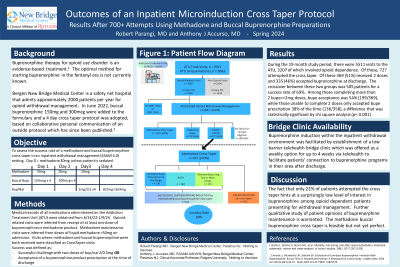Back


(7) Outcomes of an Inpatient Microinduction Cross Taper Protocol, Results After 700+ Attempts
Friday, April 5, 2024
9:45 AM – 1:15 PM

Has Audio

Robert Parangi, MD
Lead Physician of Addiction Treatment Unit
Bergen New Bridge Medical Center, New Jersey
Anthony J. Accurso, MD, FASAM, AAHIVS
Medical Director of Addiction Medicine
Bergen New Bridge Medical Center, New Jersey
Presenter(s)
Non-presenting author(s)
Background & Introduction: Buprenorphine therapy for opioid use disorder is now a well-established patient-centered treatment modality. The shift in drug supply towards fentanyl based products has made starting buprenorphine more difficult for patients and providers alike.
In July 2022, our safety net hospital began a cross-taper protocol, starting patients on a methadone down-taper and simultaneously a buccal-buprenorphine up-taper.
Day 0: Methadone 30, Day 1 Methadone 30, buprenorphine 150mcg x 4, Day 2 Methadone 20, buprenorphine 300mcg x 4, Day 3 Methadone 10mg, bup/nal 2/0.5 x 4. (Arnouk et al, 2023 PMID: 37847570)
This cross taper protocol has now been tried 727 times and its outcomes are described below. Overall interest in buprenorphine therapy among opioid dependent patients presenting for inpatient withdrawal management was also assessed.
Methods: We conducted a retrospective analysis of medication orders at Bergen New Bridge Medical Center, a large safety-net hospital in New Jersey with a 50-bed withdrawal management unit, from 6/14/2022 - 1/9/2024. All medication administrations on the unit were obtained and opioid-dependence visits were inferred from the medication orders. Opioid treatment pathways were determined from the combination of methadone, buccal buprenorphine and sublingual buprenorphine that was administered. Cross-taper attempts were defined as patients who received buccal buprenorphine as well as methadone tablets. Successful cross-taper was defined as receipt of two doses of buprenorphine product >= 2mg and/or acceptance of a buprenorphine prescription at the time of discharge.
Results: During the study period there were 3207 visits that included treatment for opioid withdrawal management. Overall buprenorphine prescription acceptance at the time of discharge was 681/3207 (21%). Of 3207 visits, 727 patients attempted the cross taper protocol. (The remaining patient pathways were: 1175 elected methadone-only taper to zero, 776 underwent traditional buprenorphine withdrawal management, 80 elected buprenorphine-only induction, 232 were on methadone from an OTP, 100 patients were on stable home buprenorphine and 117 patients were not well categorized). Buprenorphine prescriptions were written at discharge for 335/727 (46%) patients, and 2 or more inpatient buprenorphine doses >2mg were completed for 369/727 (51%). Defining successful outcome as either condition or both, the cross-taper success rate was 505/727 (69%). Among those completing more than 2 buprenorphine>=2mg doses, buprenorphine acceptance was 54% (199/369), while those unable to complete 2 doses only accepted buprenorphine prescription 38% of the time (136/358), a difference that was statistically significant by chi square analysis (p < 0.001).
Conclusion & Discussion: Our study displays a large scale pragmatic experience with a methadone-buccal buprenorphine cross taper protocol, building on work from a previously published single-site cohort study (Arnouk, 2023). Cross-taper may represent a more humanistic method of transitioning from fentanyl-based opioid to buprenorphine maintenance, although its success rate is not perfect. The optimal method of buprenorphine induction in the context of fentanyl is still not clear. Also of note, only a minority of opioid dependent patients presenting for opioid withdrawal management at our safety net hospital seek buprenorphine as their continued treatment strategy, despite it being offered to all of them. Further study about patient preferences and experiences with buprenorphine would be beneficial.
References: Arnouk S, Wunderlich JR, Sidelnik SA. Evaluation of low-dose buprenorphine initiation with buprenorphine buccal films in hospitalized patients: a retrospective cohort study. J Addict Med. Published online October 17, 2023.
Cohen SM, Weimer MB, Levander XA, Peckham AM, Tetrault JM, Morford KL. Low dose initiation of buprenorphine: a narrative review and practical approach. J Addict Med. 2022;16(4):399-406.
De Aquino JP, Parida S, Sofuoglu M. The pharmacology of buprenorphine microinduction for opioid use disorder. Clin Drug Investig. 2021;41(5):425-436.
Wakeman SE, Larochelle MR, Ameli O, et al. Comparative effectiveness of different treatment pathways for opioid use disorder. JAMA Netw Open. 2020;3(2):e1920622.
In July 2022, our safety net hospital began a cross-taper protocol, starting patients on a methadone down-taper and simultaneously a buccal-buprenorphine up-taper.
Day 0: Methadone 30, Day 1 Methadone 30, buprenorphine 150mcg x 4, Day 2 Methadone 20, buprenorphine 300mcg x 4, Day 3 Methadone 10mg, bup/nal 2/0.5 x 4. (Arnouk et al, 2023 PMID: 37847570)
This cross taper protocol has now been tried 727 times and its outcomes are described below. Overall interest in buprenorphine therapy among opioid dependent patients presenting for inpatient withdrawal management was also assessed.
Methods: We conducted a retrospective analysis of medication orders at Bergen New Bridge Medical Center, a large safety-net hospital in New Jersey with a 50-bed withdrawal management unit, from 6/14/2022 - 1/9/2024. All medication administrations on the unit were obtained and opioid-dependence visits were inferred from the medication orders. Opioid treatment pathways were determined from the combination of methadone, buccal buprenorphine and sublingual buprenorphine that was administered. Cross-taper attempts were defined as patients who received buccal buprenorphine as well as methadone tablets. Successful cross-taper was defined as receipt of two doses of buprenorphine product >= 2mg and/or acceptance of a buprenorphine prescription at the time of discharge.
Results: During the study period there were 3207 visits that included treatment for opioid withdrawal management. Overall buprenorphine prescription acceptance at the time of discharge was 681/3207 (21%). Of 3207 visits, 727 patients attempted the cross taper protocol. (The remaining patient pathways were: 1175 elected methadone-only taper to zero, 776 underwent traditional buprenorphine withdrawal management, 80 elected buprenorphine-only induction, 232 were on methadone from an OTP, 100 patients were on stable home buprenorphine and 117 patients were not well categorized). Buprenorphine prescriptions were written at discharge for 335/727 (46%) patients, and 2 or more inpatient buprenorphine doses >2mg were completed for 369/727 (51%). Defining successful outcome as either condition or both, the cross-taper success rate was 505/727 (69%). Among those completing more than 2 buprenorphine>=2mg doses, buprenorphine acceptance was 54% (199/369), while those unable to complete 2 doses only accepted buprenorphine prescription 38% of the time (136/358), a difference that was statistically significant by chi square analysis (p < 0.001).
Conclusion & Discussion: Our study displays a large scale pragmatic experience with a methadone-buccal buprenorphine cross taper protocol, building on work from a previously published single-site cohort study (Arnouk, 2023). Cross-taper may represent a more humanistic method of transitioning from fentanyl-based opioid to buprenorphine maintenance, although its success rate is not perfect. The optimal method of buprenorphine induction in the context of fentanyl is still not clear. Also of note, only a minority of opioid dependent patients presenting for opioid withdrawal management at our safety net hospital seek buprenorphine as their continued treatment strategy, despite it being offered to all of them. Further study about patient preferences and experiences with buprenorphine would be beneficial.
References: Arnouk S, Wunderlich JR, Sidelnik SA. Evaluation of low-dose buprenorphine initiation with buprenorphine buccal films in hospitalized patients: a retrospective cohort study. J Addict Med. Published online October 17, 2023.
Cohen SM, Weimer MB, Levander XA, Peckham AM, Tetrault JM, Morford KL. Low dose initiation of buprenorphine: a narrative review and practical approach. J Addict Med. 2022;16(4):399-406.
De Aquino JP, Parida S, Sofuoglu M. The pharmacology of buprenorphine microinduction for opioid use disorder. Clin Drug Investig. 2021;41(5):425-436.
Wakeman SE, Larochelle MR, Ameli O, et al. Comparative effectiveness of different treatment pathways for opioid use disorder. JAMA Netw Open. 2020;3(2):e1920622.
Learning Objectives:
- Learners will be able to describe cross-taper as a tool for buprenorphine micro-induction within a hospital context.
- Learners will be able to describe the statistic of 21% as the measured rate of buprenorphine interest within the population presenting to this safety net hospital.
- Learners will be able to define buccal-buprenorphine as an option for micro-induction onto buprenorphine.
